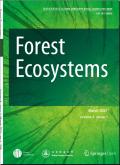在温带落叶松人工林中,坡度对幼树沿海拔梯度的干旱敏感性起中介作用,但不影响其干旱恢复
IF 4.4
1区 农林科学
Q1 FORESTRY
引用次数: 0
摘要
气候变暖导致山地物种向高海拔地区迁移。海拔对山区生长-气候关系的影响已被深入研究。然而,微地形如何影响树木生长及其沿海拔梯度的抗旱性仍然知之甚少。本文利用华北落叶松年轮数据网络,在海拔970 ~ 1869 m的海拔梯度范围内,研究了海拔梯度对落叶松生长和抗旱性的影响。生长季节干旱和温度是限制研究区落叶松生长的主要气候因子。小于40年的落叶松在陡坡(10°~ 35°)比平缓坡(0°~ 5°)和平缓坡(5°~ 10°)表现出更强的基础面积增量(BAI)与高程的正相关。在低海拔陡坡上,40年以下落叶松生长与Palmer干旱严重指数(PDSI)的相关性较强。在陡坡上,幼龄落叶松的抗逆性和恢复力均随海拔梯度的增加而增加,而老龄落叶松的抗逆性和恢复力均不增加。不同年龄层落叶松的干旱恢复能力随海拔的升高无显著差异。我们的研究结果强调,干旱事件可能特别影响低海拔陡峭斜坡上落叶松幼树的生长,对死亡率有潜在的影响。本文章由计算机程序翻译,如有差异,请以英文原文为准。
Slope mediates drought sensitivity but does not affect drought recovery for young trees along elevation gradients in temperate planted larch forests
Climate warming causes mountainous species to shift their distributions towards higher elevations. How elevation influences growth–climate relationship in mountain regions has been intensively investigated. However, how microtopography shapes tree growth and its drought resistance along the elevation gradient remains poorly understood. We used a network of Larix principis-rupprechtii tree-ring data comprising 1,918 trees from different age classes and mountain slopes, along an elevation gradient ranging from 970 to 1,869 m, to investigate how slope gradients mediate the growth and drought resilience of larch trees along an elevation gradient in North China. Growing season drought and temperature were the major limiting climatic factors for larch trees across the study region. Larch trees younger than 40 years exhibited a stronger positive correlation between basal area increment (BAI) and elevation on steep slopes (10°–35°) than on flat (0°–5°) or gentle (5°–10°) slopes. At low-elevation steep slopes, the growth of larch trees younger than 40 years showed a stronger correlation with the Palmer drought severity index (PDSI). Both resistance and resilience were found to increase along the elevation gradient on steep slopes for young larch trees but not for old larch trees. No significant differences were observed in the drought recovery ability of larch trees across all age groups at increasing elevation. Our results highlight that drought events may particularly affect the growth of young larch trees on low-elevation steep slopes, with potential repercussions on mortality rates.
求助全文
通过发布文献求助,成功后即可免费获取论文全文。
去求助
来源期刊

Forest Ecosystems
Environmental Science-Nature and Landscape Conservation
CiteScore
7.10
自引率
4.90%
发文量
1115
审稿时长
22 days
期刊介绍:
Forest Ecosystems is an open access, peer-reviewed journal publishing scientific communications from any discipline that can provide interesting contributions about the structure and dynamics of "natural" and "domesticated" forest ecosystems, and their services to people. The journal welcomes innovative science as well as application oriented work that will enhance understanding of woody plant communities. Very specific studies are welcome if they are part of a thematic series that provides some holistic perspective that is of general interest.
 求助内容:
求助内容: 应助结果提醒方式:
应助结果提醒方式:


